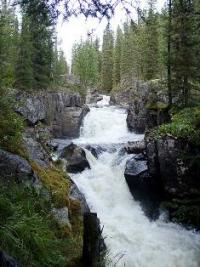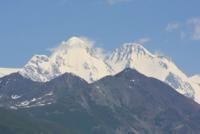You are here
Exploration Kazakhstan Altai.




Horse riding in Kazakh Altai mountains.
"Sun-bathed, blue-haloed summits, peaks, jagged ridges, conical hills, slopes and valleys; it was mountains cape of such splendour that the soul cheered at the sigh: of it"
Alfred Brehm.
Tours Kazakh Altay.
In the early XVIIIth Century, having consolidated all of Siberia under the Russian crown, Tsar Peter I was interested most in expanding his sphere of influence towards ihe east, and China in particular.
Between Russia and China lay the Kazakh steppe. The steppe I lands bordering southern Siberia and the Altai Mountains were the most easily reached, so Peter prepared a large expedition.
In the early summer of 1715, Colonel Buchholtz led 3,000 men from the Siberian fortress of Tobolsk towards the Altai. They followed the course of the Irtysh River (Ertis or Yertis in Kazakh), and in 1716 built ihe fortresses of Omsk and Yamyshevsk.
These served as bases for a new expedition, which set out in 1717 to drive further upstream on the Irtysh. Under the command of I. Stupkin the fortresses of Zhelezinsk and Semipalatinsk were founded.
Between 1719 and 1720, led by Ivan Likharyov, the mission extended further with the foundation of the fortresses Ust-Kamenogorsk and Koryakovsk. With them, the Irtysh defence line wis completed, and it was to play a crucial role in Russia's defence against the brutal Zhungars and other would-be invaders.
It also played an important strategic role in the gradual colonization of the Kazakh tribes. Tsar Peter acknowledged that this was the key to the "Gate of the East". Of all Kazakhstan's many regions, no other is so steeped in legend as the Altai. It is the original homeland of the Turkic nations, and contains impressive rock carvings and mysterious tombstones dating back millennia.
The legendary peaks of Shambhala and Byelovodye, and the double peak of Mount Byelukha (considered the "navel of the Earth") are still the home of shamanism, giving the Altai a mystical reputation.
Geologists, archaeologists, ethnologists, botanists and zoologists have all come here from around the word drawn by this ancient mountain region's many treasures. The great German explorer Alexander von Humboldt travelled through the area in 1829, sponsored by Tsar Nicolas I to explore and report on what he discovered; the result was Von Humboldt's masterpiece, A Sketch of the Physical Description of the Universe.
Only a small part of this large mountain range in the heart of Asia is situated in Kazakhstan. The major part of the Altai, with its continuation into the Sayany Mountains, is in Russian territory, while another large section stretches into China and further into Mongolia.
The mountains are incredibly rich in natural splendour, home to rare plants and animals, historical landmarks and other places of geological and anthropological interest. Not without justification is this region called the Altai, meaning "Golden Mountain" in Mongolian.
Scientists called the Altai a "concise continent", a term that reflects the extraordinary variety of landscapes found within its relatively limited area: there is desert and steppe, low mountain chains covered from 600 - 2,000 metres altitude with taiga forest (accounting for 47 percent of the region), more than 300 high mountain peaks covered with glaciers (on Kazakhstani territory alone), and approximately 2,000 lakes and 1,200 rivers.
Twenty- seven species of reptile, 36 fish species and 333 types of bird call Kazakhstan's Altai home. The World Wide Fund for Nature (WWF) has included the entire Altai in its list of 200 areas in the world with exceptionally important value in terms of biodiversity.
Kazakhstan has acknowledged this by putting large areas of its share of the Altai under protection. Visitors to the Altai should be aware that they are guests in a by and large untouched realm and should behave accordingly.
It would be easy to spend several weeks or months in the rolling steppe, foothills, valleys and high mountains of the Altai, without losing interest or enthusiasm in the many and varied experiences it offers.
Everything from inexpensive two-day excursions to lengthy Altai tours by car, bicycle, boat, on horseback or hiking are possible. The city of Oskemen (Ust-Kamenogorsk) is the most convenient starting and finishing point for trips.
Since many of the finest areas are situated in the border area with China, the obligatory permits are required, though arrangements can be made through any authorised agency without too much trouble.
The climate in the Altai is uncharacteristic for Kazakhstan. Winters are long and harsh, with snow often more than two metres deep, while summers are relatively cool, especially in the mountainous areas.
Rain is also more abundant, both in summer and winter. Altai is the part of the largest mountain system named Altai-Sayan Mountains, the borders of which extend from Zaisan Lake to Baikal Lake.
Kazakhstan has only its south-western part. The southern border is the basin of Black Irtysh River and Zaisan Lake, and the western border is Kalbinsky Ridge. According to the relief peculiarities, Kazakh Altai is divided into three areas: Southern Altai, Rudny Altai and Kalbinsky Ridge.
The Kazakhstan Altai consists of the Western Altai, Southern Altai and ridge Kalba (Н-1608). The western Altai - is rich with minerals, therefore this part of Altai name Rudnyi. The Western Altai between the rivers Uba, in northeast between Bukhtarma is located.
Consists of ridges Kogronskiy, Tigirezkiy, Kholzun ridges Ubainskiy (Н-1800 - 2000), Ivanovskiy (Н-2800) and Ulbinskiy (Н-1800 - 2200). The word "taiga" in language of Altay people means «a wood on mountains».
Southern Altai is plateau Ukok and Bukhtarma valley, a plateau. Flat tops, are combined with depression in which many lakes were formed. The highest point of ridge Kalba - mountain Saryshoku.
Kalba - edge of fantastically beautiful lakes. Of all Kazakhstan's many regions, no other is so steeped in legend as the Altai. It is the original homeland of the Turkic nations, and contains impressive rock carvings and mysterious tombstones dating back millennia.
Authority:
The guidebook across Kazakhstan . Authors Dagmar Schreiber and Jeremy Tredinnick. Publishing house "Odyssey". 2010.
Photos
Alexander Petrov.







